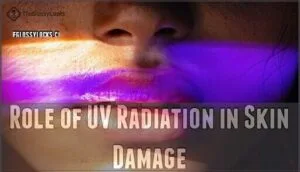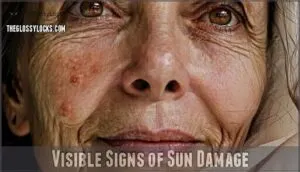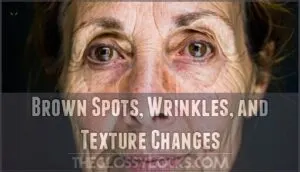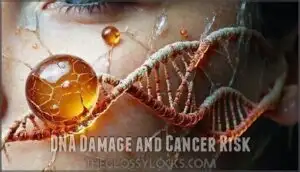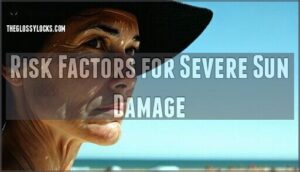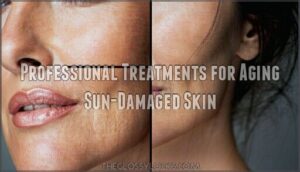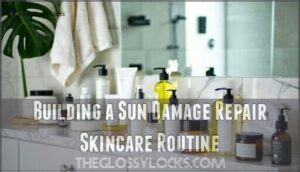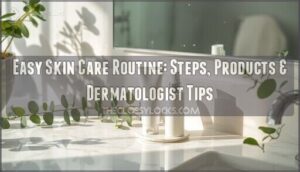This site is supported by our readers. We may earn a commission, at no cost to you, if you purchase through links.
 If you’re staring down sun damage repair for aging skin, don’t fret—there’s hope for every wrinkle and freckle.
If you’re staring down sun damage repair for aging skin, don’t fret—there’s hope for every wrinkle and freckle.
UV rays may have given your skin a patchwork of brown spots, lines, and rough texture, but tools like vitamin C serums, retinol, and sunscreen help even things out and boost brightness.
Moisturizers with hyaluronic acid and soothing aloe vera bring back softness, while exfoliants gently sweep away dullness, giving skin a second wind.
Pull on a hat and sunglasses for bonus points, and remember, every face tells a story—yours just might get a refresh before the last chapter with the help of retinol and sunscreen.
Table Of Contents
- Key Takeaways
- Causes and Signs of Sun-Damaged Aging Skin
- Photoaging Vs. Chronological Skin Aging
- Risk Factors for Severe Sun Damage
- Preventing Further Sun Damage
- At-Home Remedies for Sun Damage Repair
- Professional Treatments for Aging Sun-Damaged Skin
- Top 10 Products for Sun Damage Repair
- 1. Sun Damage Repair Resurfacing Cream
- 2. No7 Future Renew Face Serum
- 3. No7 Future Renew Night Cream
- 4. EltaMD UV Restore Sunscreen SPF 40
- 5. Robanda Retinol Anti Aging Hand Cream
- 6. Medix 5.5 Retinol Collagen Cream Set
- 7. JUMISO Snail Mucin Peptide Essence
- 8. Sibu Sea Buckthorn Night Cream
- 9. Ombré Sun Protection Skin Supplement
- 10. Waxhead Rosehip Seed Oil Face Serum
- Building a Sun Damage Repair Skincare Routine
- Frequently Asked Questions (FAQs)
- Can skin care products reverse sun damage?
- What are the best treatments for sun-damaged skin?
- Is sun damage hard to treat?
- Can you reverse aging from sun damage?
- Can sun-damaged skin be repaired?
- Is it too late to fix sun-damaged skin?
- What is the new treatment for sun-damaged skin?
- How does diet affect sun damage repair?
- Can makeup protect against further sun damage?
- Are natural oils effective in sun damage treatment?
- Conclusion
Key Takeaways
- You can fade spots, smooth texture, and boost radiance by using sunscreen daily, antioxidant serums, and retinoid products.
- Protective clothing, hats, and seeking shade are essential alongside sunscreen for defending your skin against new sun damage.
- Consistent use of targeted skincare, plus pro treatments like chemical peels or lasers, help restore firmness and even skin tone.
- Healthy habits like eating antioxidant-rich foods, drinking water, and tracking skin changes make your results last longer.
Causes and Signs of Sun-Damaged Aging Skin
When you spend time in the sun without much protection, UV rays can cause skin to age faster, leading to dryness, deep wrinkles, brown spots, and a leathery texture.
Sun exposure ages skin quickly, bringing dryness, deep wrinkles, brown spots, and a leathery feel you can’t ignore
These changes don’t just alter how your skin looks—they signal that invisible damage is happening beneath the surface.
Role of UV Radiation in Skin Damage
From sunrise to sunset, UV radiation is a major culprit behind sun damaged skin.
Here’s how it sneaks in:
- UVB effects burn the skin’s upper layers.
- UVA penetration goes deeper, sabotaging collagen.
- DNA damage and free radicals kick off aging skin repair.
- Melanin protection helps, but not enough—consistent UV protection is essential for skin rejuvenation and sun damage treatment.
The process involves multiple steps that lead to skin damage, highlighting the need for preventive measures against sun damaged skin.
Visible Signs of Sun Damage
After learning how UV rays harm your skin, you’ll spot the telltale clues—Sunspots, deeper Wrinkle Depth, rough Texture Changes, and stubborn Discoloration.
You may even notice Skin Sagging setting in before you expect it.
Recognizing these visible marks is your first step toward aging skin repair, sun damage treatment, skin rejuvenation, and effective age spot removal.
| Sign | Look For | Common Area |
|---|---|---|
| Sunspots | Brown patches | Cheeks, hands |
| Texture Changes | Rough patches | Chin, arms |
| Wrinkle Depth | Deep creases | Forehead, eyes |
| Skin Sagging | Loose skin | Jawline, neck |
| Discoloration | Uneven tone | Face, chest |
Brown Spots, Wrinkles, and Texture Changes
When you notice brown spots popping up, wrinkles deepening, and your skin’s texture turning rough, you’re seeing classic signs of sun damage.
Tackling these issues means focusing on Spot Removal, Wrinkle Reduction, and Texture Improvement.
Treatments like skin resurfacing and Collagen Stimulation can fade age spots, reduce fine lines, and improve skin tone, restoring skin’s best version.
Loss of Elasticity and Uneven Tone
Along with brown spots and wrinkles, you might start to see the loss of elasticity and uneven tone in your skin.
Collagen breakdown and elastin damage make your skin less firm, while hyperpigmentation and texture irregularities become more noticeable.
To tackle these changes, try:
- Skin firming creams
- Redness reduction serums
- Gentle exfoliating for mature skin care
- Antiaging solutions for fine line reduction
Photoaging Vs. Chronological Skin Aging
When you look in the mirror, it’s easy to wonder whether the wrinkles and spots you see are part of the natural aging process or caused by years in the sun.
Understanding how photoaging, triggered by UV exposure, differs from chronological aging will help you make smarter choices for your skin’s long-term health.
Key Differences in Skin Changes
You’ve seen how wrinkles and brown spots start to show, but what sets photoaging apart from Intrinsic Aging.
Natural aging moves slowly, led by genetics, while Extrinsic Factors like sun speed up Cellular Changes.
Here’s a quick side-by-side:
| Intrinsic Aging | Photoaging |
|---|---|
| Gradual Elasticity Loss | Sudden Pigmentation Variance |
| Fine line reduction slow | More uneven skin tone |
| Thinner mature skin | Thicker, leathery feel |
| Uniform texture | Patchy, rough areas |
The key differences between Intrinsic Aging and photoaging are significant, with Intrinsic Aging moving at a slower pace and Extrinsic Factors contributing to more rapid Cellular Changes.
DNA Damage and Cancer Risk
If you’re weighing the impact of UV mutations on your skin, remember DNA changes from sun exposure often mean irreversible damage.
This isn’t about genetics alone—cellular repair can’t undo everything. Prioritize cancer prevention alongside antiaging solutions.
Effective skin aging prevention helps with skin elasticity and firming, making facial rejuvenation safer and more effective when damage is caught early.
| Risk Factor | Damage Type | What Helps |
|---|---|---|
| UV Mutations | Irreversible Damage | Skin Aging Prevention |
| Genetic Predisposition | Higher Cancer Risk | Cancer Prevention |
| Weak Cellular Repair | Early Aging Signs | Facial Rejuvenation |
Areas Most Affected by Photoaging
Over the years, you’ll see photoaging take center stage on your face, neck, hands, chest, and legs—these areas get the most sun.
Facial photoaging can cause texture changes and fine lines, while neck damage and hand aging mean visible sunspots and lost skin elasticity.
Don’t forget proven antiaging solutions; skin firming and mature skin care matter.
| Area | Unique Impact |
|---|---|
| Face | Wrinkles, uneven tone |
| Neck | Sagging, texture loss |
| Hands | Brown spots, visible veins |
| Chest | Sunspots, loss of firmness |
| Legs | Thin skin, rough patches |
The table highlights the unique impact of photoaging on different body parts, emphasizing the need for targeted skin care approaches to address these concerns.
Risk Factors for Severe Sun Damage
You’re more likely to face serious sun damage if your skin burns easily, you work or play outside often, or you take certain medications.
Recognizing these risk factors can help you take steps now to protect your skin from lasting harm, and this understanding is key to preventing serious sun damage.
Skin Type and Genetic Predisposition
Factoring in your ancestry, melanin production, and unique genetic factors, your skin’s sensitivity to sun damage will differ from your neighbor’s.
While some benefit from natural skin firming, others may need a boost with collagen-boosting or antioxidant serums.
Mature skin care routines with retinol products help counteract individual variation, making a smart defense against those unpredictable genetics.
Lifestyle and Environmental Exposure
After considering how your skin type shapes sun sensitivity, it’s time to think about daily habits and where you live.
Long Outdoor Activities, city living’s Pollution Effects, a diet lacking Dietary Antioxidants, Smoking Impact, and Altitude Exposure all push your skin closer to damage.
Reach for antioxidant serums, collagen boosting peptide creams, retinol products, and prioritize daily skin hydration.
Health Conditions and Medications
Living with certain health conditions means you need extra sun care. Autoimmune diseases and immunosuppressants can make your skin more sensitive.
Watch out for these three risk factors:
- Medications—corticosteroids, antibiotics, and oral contraceptives—can increase sun sensitivity.
- Skin hydration, antioxidant serums, and collagen boosting help repair.
- Peptide creams and retinol products support recovery and defense.
These factors are crucial for individuals with certain health conditions to manage their sun care effectively and maintain healthy skin.
Preventing Further Sun Damage
You can’t erase years of sun exposure, but you can take smart steps now to prevent further damage and keep your skin looking its best.
Using sunscreen daily, wearing protective clothing, and avoiding tanning beds will help you protect your skin and maintain the results of your repair routine.
Daily Sunscreen Use and Application Tips
If your skin could talk, it might demand SPF broad-spectrum sunscreen every morning. Choose a formula with effective sunscreen ingredients, aiming for a nickel-sized application amount per area.
Don’t forget reapplication frequency, especially under strong sun illumination or high light intensity. Pay attention to the sunlight spectrum—visible wavelengths can sneak through clouds and still accelerate sun damage if you’re careless.
Many people are now embracing consistent sun protection.
| Choosing Sunscreen | Application Amount |
|---|---|
| SPF Broad-spectrum | Nickel-sized per area |
| Effective Ingredients | Face, neck, ears, hands |
| Avoid Harmful Additives | Consistent coverage |
| Lightweight Texture | Reapply every 2 hours |
| Water Resistance | Don’t miss hairlines |
Protective Clothing and Accessories
If sunscreen’s your first shield, think of protective clothing and accessories as your reliable backup.
Fabric matters—a tightly woven shirt, a broad-brimmed hat (hat selection counts!), and UV-blocking sunglasses all boost your defense.
UPF clothing ratings make choosing easier. Check coverage area: more fabric, more safety.
Stylish options exist, so you don’t have to sacrifice comfort for protection.
Limiting Sun Exposure and Seeking Shade
You’ve got your sun-protective gear ready, but dodging UV rays takes more than just a good hat.
Stick to the shade when the sun’s beating down, especially during peak sun hours.
Keep an eye on the UV Index—it’s your guide to safe times outdoors.
Use shade structures and location-based protection for everyday, stealthy safeguarding.
Avoiding Tanning Beds and Sunlamps
A glowing tan from tanning beds or sunlamps may seem tempting, but skipping them helps your skin avoid major cancer risks and premature aging.
These UV alternatives bombard you with intense illumination beyond the visible part spectrum.
Regulation efforts and education campaigns target rising teen usage, remembering that there’s no safe way to simulate sunlight—no matter how you measure brightness or total power sunlight, which poses significant premature aging concerns.
At-Home Remedies for Sun Damage Repair
You don’t have to book a dermatologist appointment to start tackling sun damage—many proven remedies are already in your home skincare routine.
With the right products and consistent care, you can improve discoloration, support your skin’s repair process, and see visible results over time.
Vitamin C Serum for Brightening
Brighten your day—and your skin—by letting Vitamin C serum handle stubborn sun spots.
Vitamin C serum delivers daily brightness and helps stubborn sun spots fade for a more radiant complexion
Look for a Serum Concentration between 10-20%, and check for Antioxidant Synergy with vitamin E or ferulic acid.
For best Application Techniques, use morning and SPF.
Product Stability matters: avoid light and air.
Explore serum options for ideal results.
Sensitive skin? Start gradually to reduce irritation.
Retinol and Retinoid Treatments
Someone reaching for smoother skin might wonder about Retinol and Retinoid treatments.
Choosing the right Retinoid Strength can feel like picking a reference frame in a philosophical point—context matters.
Start slow with retinol alternatives, layer products carefully, and watch for side effects.
Many turn to retinol for anti-aging to address these concerns.
Prescription Retinoids pack more punch but require care, much like choosing between heliocentric and geocentric systems.
Chemical and Physical Exfoliants
In the context of exfoliating, it’s a balancing act—think AHA vs. BHA.
For sensitive skin, start slow and adjust your exfoliation frequency to avoid irritation.
Pairing physical scrubs with chemical exfoliants isn’t wise, as it can overwhelm your skin.
Always follow with gentle post-exfoliation care to help soothe and protect your skin’s natural moisture barrier and maintain a healthy balance, considering the importance of exfoliation.
Hydrating and Soothing Ingredients
After a long day in the sun, your skin’s begging for comfort.
Reach for hydrating ingredients like Hyaluronic Acid and Ceramides—perfect for replenishing moisture and supporting your skin barrier.
Oatmeal Soothing and Aloe Vera calm redness, while Green Tea brings antioxidant benefits.
Consistent use of these remedies can help with sun damage repair.
Together, these simple remedies keep your skin soft, soothed, and looking well cared-for with complete concepts of skin care.
Professional Treatments for Aging Sun-Damaged Skin
When sunscreen and serums just aren’t cutting it, professional treatments can offer dramatic results for aging, sun-damaged skin.
You’ll find options like chemical peels, lasers, and injectables that target wrinkles, dark spots, and rough texture, helping restore a smoother, healthier complexion.
Chemical Peels and Dermabrasion
After exploring at-home fixes, you might wonder what’s next for deeper damage.
Chemical peels can vary in peel depth, targeting different skin layers for impressive results.
Dermabrasion risks include irritation but, when done right, lead to smoother skin.
Laser skin rejuvenation can also target wrinkles.
Recovery time depends on the reference frame of your daily life, but clear improvement and unique position in treatment combinations make these truly effective cosmological model choices with impressive results.
Laser and Light-Based Therapies
Radiative equilibrium is key when considering Laser Resurfacing or IPL Therapy for sun-damaged skin.
Fractional Lasers use specific light wavelengths—much like the continuous spectrum of the solar photosphere—to target damage with precision.
Expect some treatment downtime, but visible wavelengths and customized energy settings mean better safety for various atomic species (skin types), leading to clearer, smoother skin long-term, which is a result of achieving radiative equilibrium and using Fractional Lasers.
Microneedling and Radiofrequency
If you’ve ever wished for smoother, tighter skin without much downtime, RF Microneedling might be your answer.
This treatment combines traditional microneedling with radiofrequency energy, boosting collagen stimulation deep below the surface.
It’s customizable—your provider can adjust the treatment depth for your skin’s needs.
Most people experience mild redness, but you’ll be back to your routine quickly, which makes it a great option for those looking for a treatment with minimal downtime.
Injectables and Fillers
After microneedling, you might look for more ways to boost skin rejuvenation.
Enter injectables and fillers, which can provide a solution to enhance your appearance. Facial fillers and dermal injections can soften deep wrinkles, while wrinkle relaxers deliver smoother results.
Lip augmentation adds volume where you want it, and these in-office options, like measuring brightness or adjusting a light bulb, give you more control over visible signs of aging.
Top 10 Products for Sun Damage Repair
If you’re searching for proven ways to repair sun-damaged skin, choosing the right products can make all the difference.
Here you’ll find a carefully selected list of the top options designed to help restore your skin’s health, even if you’ve spent a few extra summers outdoors.
1. Sun Damage Repair Resurfacing Cream
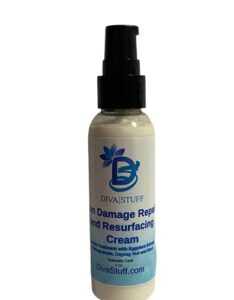
If you’re hoping for real change in your skin, Sun Damage Repair Resurfacing Cream packs a potent punch.
It blends natural staples like lavender, pomegranate, and vitamin C, with ingredients aimed at fading sun spots and evening out rough patches.
A little goes a long way; the two-ounce pump bottle lasts for weeks.
While the lavender scent isn’t everyone’s cup of tea, you’ll appreciate the non-greasy feel and reliable results—especially if daily sun exposure has left your skin looking weathered or dull.
Understanding skin care routines is essential for maintaining healthy skin and preventing further damage.
Best For: Anyone with sun-damaged, dull, or uneven skin looking for natural repair and visible brightening.
- Noticeably reduces sun spots and discoloration with regular use
- Absorbs quickly, leaving skin moisturized without a greasy residue
- Concentrated formula lasts over a month from a small pump bottle
- Strong lavender scent that’s polarizing among users
- Smaller bottle size may seem underwhelming for the price
- Results require consistent daily application for several weeks
2. No7 Future Renew Face Serum
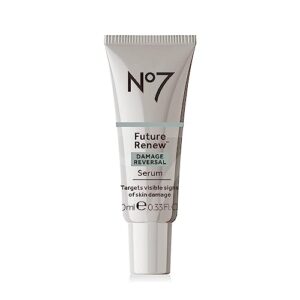
Blending smart science with simplicity, No7 Future Renew Face Serum tackles sun damage head-on.
Packed with “Pepticology”—a fancy way of saying it helps your skin repair itself—it hydrates, brightens, and plays well with makeup.
Many users notice firmer, smoother skin within a week, thanks to hyaluronic acid and niacinamide.
Although it’s not a magic eraser for all wrinkles, it consistently improves tone, fading sunspots and boosting confidence.
For best results, pair with daily sunscreen and other No7 products.
Best For: Women with normal or mature skin seeking affordable, dermatologist-approved repair for sun-damaged, uneven, or aging skin.
- Not specifically designed to treat under-eye bags or neck wrinkles; Clinique eye creams may work better for these areas.
- Full benefits require consistent use and pairing with sunscreen or other No7 products.
- International buyers may face customs issues with limited refund support.
- Noticeably brightens, firms, and hydrates skin, with visible improvements often in just one week.
- Lightweight, unscented, and absorbs quickly without greasiness—suitable for sensitive types and daily use under makeup.
- Backed by clinical testing and high user satisfaction for fading sun damage and improving skin tone.
3. No7 Future Renew Night Cream
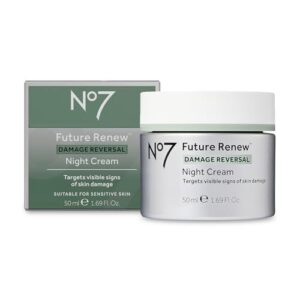
Anyone looking to reverse sun damage while catching up on sleep should try No7 Future Renew Night Cream.
This peptide-rich formula supports your skin’s natural renewal process, helping hydrate, firm, and smooth out fine lines overnight.
Packed with niacinamide and antioxidants, it tackles brown spots and uneven tone, while a creamy texture keeps your skin moisturized without feeling greasy.
It’s suitable for sensitive skin, dermatologist-approved, and a consistent favorite for visible results—making it a solid addition to your nighttime skincare routine.
Best For: Anyone with sun-damaged, aging, or sensitive skin looking for overnight hydration and visible renewal.
- Results may take several weeks to become noticeable.
- Caution needed when buying online due to potential duplicates.
- Some may find the powdery scent less appealing.
- Clinically proven to reduce fine lines, improve firmness, and even skin tone.
- Lightweight, non-greasy texture absorbs quickly and layers well.
- Dermatologist-approved and suitable for sensitive skin.
4. EltaMD UV Restore Sunscreen SPF 40
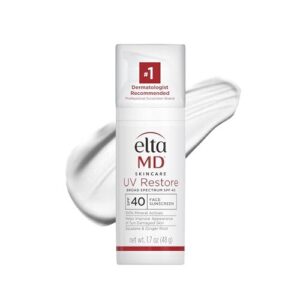
You’ll often find that using EltaMD UV Restore Sunscreen SPF 40 is like giving your skin a daily insurance policy against the sun.
This mineral sunscreen delivers broad-spectrum protection with zinc oxide and titanium dioxide, shielding you from both UVA and UVB rays.
Its lightweight formula hydrates, repairs, and won’t clog pores, making it ideal for sensitive, aging, or sun-damaged skin.
Dermatologist-recommended, it also blends well under makeup, so your skin looks even, protected, and never greasy—rain or shine, with a formula that provides daily insurance.
Best For: Those with sensitive, aging, or sun-damaged skin who want high SPF mineral protection without a greasy finish.
- Effective broad-spectrum protection with zinc oxide and titanium dioxide.
- Lightweight, hydrating formula that works well under makeup.
- Non-comedogenic and dermatologist-recommended for daily use.
- Tint may be too dark for very fair skin, especially in winter.
- Expensive compared to many other sunscreens.
- Pump dispenser can be inefficient and inconsistent.
5. Robanda Retinol Anti Aging Hand Cream

Robanda Retinol Anti Aging Hand Cream is your go-to for reversing sun damage on hardworking hands.
With retinol, niacinamide, and vitamin E, it packs a punch against age spots, roughness, and fine lines.
The formula absorbs quickly, never feels greasy, and moisturizes deeply, helping your skin feel smoother and look brighter.
Users frequently notice fading dark spots and firmer skin after just a few weeks.
Sunscreen in the mix means you’re fighting future sun damage every time you put it on.
Best For: Anyone looking to reduce sun spots, wrinkles, and dryness on their hands, especially those with visible sun damage or aging concerns.
- Quickly absorbs without leaving a greasy residue.
- Fades dark spots and softens skin with regular use.
- Built-in SPF 15 protects from further sun damage.
- Results may take several weeks to become noticeable.
- Scent is light but may not appeal to everyone.
- Contains retinol, which can cause sensitivity for some users.
6. Medix 5.5 Retinol Collagen Cream Set
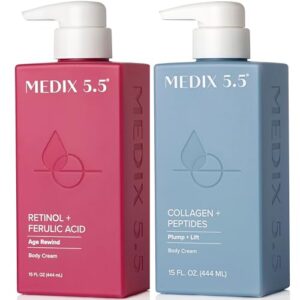
In the case of repairing sun-damaged skin, the Medix 5.5 Retinol Collagen Cream Set stands out for its blend of retinol, collagen, and hydrating botanicals.
You’ll notice smoother skin, a brighter tone, and fewer dark spots with consistent use.
The set’s pH-balanced, dermatologist-tested formula won’t leave you guessing about safety, and it’s great for sensitive areas, too.
Just remember to patch test first, start slow, and always pair with sunscreen—retinol makes skin more sensitive to sunlight, so be sure to follow these precautions for the best results with sunscreen.
Best For: Adults looking to improve sun-damaged, aging, or uneven skin while prioritizing hydration and sensitivity.
- May cause dryness or redness during initial weeks, especially for sensitive users.
- Retinol increases sun sensitivity, requiring daily sunscreen application.
- Some users find the scent strong or the texture too sticky.
- Reduces wrinkles, age spots, and improves skin tone with visible results in 4-8 weeks.
- Hydrating and soothing formula with aloe, shea butter, and chamomile, suitable for sensitive skin.
- Clinically tested, cruelty-free, and pH-balanced for everyday face and body use.
7. JUMISO Snail Mucin Peptide Essence
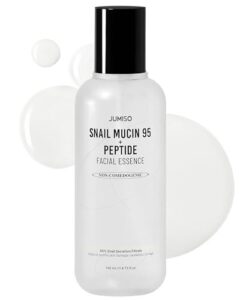
Wondering how to tackle sun-damaged skin without weighing it down?
JUMISO Snail Mucin Peptide Essence delivers with 95% snail mucin and a 5-peptide blend, helping your skin recover from UV exposure and daily stress.
It hydrates deeply, firms, and smooths texture, all in a quick-absorbing, fragrance-free formula.
Users see improved moisture and fewer fine lines in just four weeks, with real, visible repair.
Layer it morning and night under sunscreen or moisturizer for a barrier boost and to enhance your skin care routine.
Best For: Anyone seeking lightweight hydration and visible repair for sun-damaged, sensitive, or aging skin—especially those who want a non-comedogenic, fragrance-free essence.
- Deeply hydrates and strengthens skin barrier without feeling greasy.
- Clinically proven to reduce fine lines and improve texture in 4 weeks.
- Fragrance-free and safe for sensitive, acne-prone skin.
- Some users feel it’s not transformative or a “holy grail.”
- Results may be gradual rather than immediate.
- May require layering with other products for best sun damage protection.
8. Sibu Sea Buckthorn Night Cream
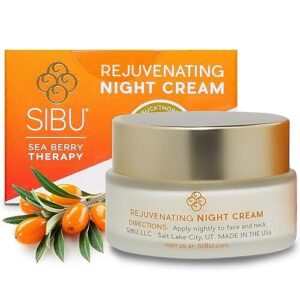
If your skin feels like it’s been through a summer marathon, Sibu Sea Buckthorn Night Cream might be your recovery plan.
Packed with sea buckthorn oil, hyaluronic acid, and antioxidants, this formula soothes and repairs sun-damaged, aging skin while you sleep.
It works on dryness, fine lines, and uneven tone, all without feeling greasy, and is suitable for sensitive skin, making it a great vegan, cruelty-free option.
Consistent nightly use brings out smoother, more hydrated, and vibrant skin.
Best For: Those seeking plant-based overnight recovery for sun-damaged, aging, or sensitive skin, including individuals experiencing hormonal changes.
- Small jar may run out quickly with regular use.
- Occasional issues with product consistency, clumping, or packaging leakage.
- Subtle fishy undertone to scent may not appeal to everyone.
- Deeply hydrates and repairs with sea buckthorn oil, hyaluronic acid, and plant extracts.
- Lightweight, non-greasy feel while targeting fine lines, dark spots, and roughness.
- Vegan, cruelty-free formula free of parabens, GMOs, and artificial preservatives.
9. Ombré Sun Protection Skin Supplement
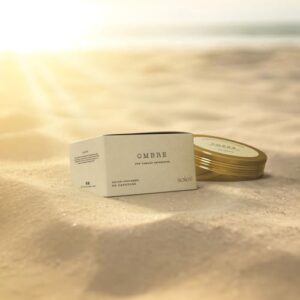
Some solutions work quietly behind the scenes—like Ombré Sun Protection Skin Supplement.
This dermatologist-formulated capsule blends Polypodium leucotomos, nicotinamide (Vitamin B3), vitamin D, and antioxidants to help your skin defend itself against UV rays.
It’s not a sunscreen substitute, but it adds a valuable layer of daily support, fighting inflammation and free radical damage.
Take two capsules a day, and pair with sunscreen for best results.
It’s easy to use, unscented, and suitable for any thorough sun-care routine.
Best For: Anyone looking to support their skin’s defense against UV damage and reduce risk of sun-related aging or irritation, especially for those with a history of sun sensitivity.
- Clinically backed to reduce skin cancer risk and sunburn
- Easy, unscented capsules that fit into any routine
- Includes anti-aging and skin-brightening ingredients
- Not a substitute for topical sunscreen
- Requires daily use for best results
- May not work as well for people expecting immediate effects
10. Waxhead Rosehip Seed Oil Face Serum
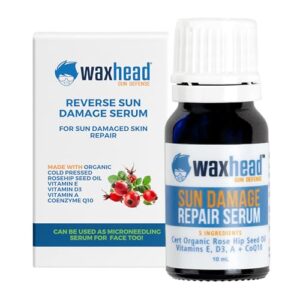
With only five pure, edible-grade ingredients, Waxhead Rosehip Seed Oil Face Serum stands out for anyone battling sun damage.
Nightly use of this non-comedogenic, hypoallergenic blend targets hyperpigmentation, fine lines, and rough texture, thanks to vitamins A, D3, E, and CoQ10.
The formula hydrates deeply, calms redness, and supports barrier recovery—without leaving your face greasy.
For best results, apply 1–3 drops to clean skin, store cool, and enjoy a brighter, smoother complexion in just weeks.
Best For: Those with sensitive, sun-damaged, or aging skin looking for gentle, fast-absorbing repair and visible improvement in tone and texture.
- Soothes redness and inflammation, ideal for rosacea or post-acne skin.
- Only five pure, organic ingredients with no fillers or irritants.
- Deeply hydrates and plumps skin without clogging pores.
- Must be stored cool or refrigerated and used within one month.
- Night-only use required due to vitamin A increasing sun sensitivity.
- Natural scent and oily texture may not suit everyone.
Building a Sun Damage Repair Skincare Routine
Creating a sun damage repair skincare routine means balancing effective ingredients, consistent habits, and practical lifestyle changes, so your efforts truly show on your skin.
As you organize your morning and night steps, you’ll want to adjust to the season, monitor your skin’s progress, and make choices that support lasting results.
You’ll also need to consider how to make these choices part of your daily routine, which can include consistent habits.
Morning and Night Skincare Steps
After choosing your top sun damage repair picks, it’s time to set up an easy skincare routine that works both day and night.
Morning Cleansing preps your face for product layering and, of course, sunscreen importance. At night, shift to Night Repair methods and keep hydration focus strong.
- Start with a gentle cleanser
- Layer products, thinnest to thickest
- Never skip sunscreen
Seasonal Adjustments and Photosensitizing Ingredients
Once you’ve nailed your morning and night steps, think about how your skincare needs to shift with the seasons.
Increased sun or cold each bring changes. Be mindful of ingredient timing—some products boost photosensitivity, so pair sunscreen reapplication with awareness.
Summer routines should also include broad-spectrum SPF 30+ for ideal protection.
After summer, focus on post-summer repair, and always adjust for photosensitivity awareness to keep Seasonal Skincare effective.
Monitoring Skin Changes and Progress
After considering the right seasonal tweaks and watching for photosensitizing products, it’s time to track your progress.
Stay vigilant—monitor your skin like you’d watch for weeds in a garden.
Use these tools:
- Snap regular Photo Documentation for honest before-and-afters
- Keep a simple Symptom Tracking log
- Schedule Professional Checkups, so small issues don’t become big headaches
Consistent use of sunscreen helps prevent accelerated photoaging.
Supporting Results With Lifestyle Choices
One smart way to boost your skincare is by tweaking daily habits, focusing on an Antioxidant Diet, solid Hydration Habits, and good Sleep Quality.
Mix in Stress Reduction and Exercise Benefits to keep your skin looking healthy and more resilient over time.
| Habit | Benefit |
|---|---|
| Antioxidant Diet | Supports skin repair |
| Hydration Habits | Plump, radiant skin |
| Sleep Quality | Boosts skin renewal |
Frequently Asked Questions (FAQs)
Can skin care products reverse sun damage?
Ever wish you could turn back time on your skin?
While no cream can truly erase sun damage, you can fade dark spots, smooth rough texture, and boost radiance with targeted products, sunscreen, and consistent care.
What are the best treatments for sun-damaged skin?
For sun-damaged skin, try a combo of sunscreen, vitamin C serums, retinoids, and gentle exfoliants.
You’ll see real results by staying consistent and protecting your skin every day with professional options like peels, lasers, or microneedling that also help.
Is sun damage hard to treat?
Treating sun damage isn’t impossible, but it takes patience and some clever moves.
While you can’t erase it completely, using sunscreen, moisturizers, and targeted treatments helps restore vibrancy and keep your skin looking its best long-term.
Can you reverse aging from sun damage?
Imagine Sarah, who loved beach vacations in her twenties.
You can’t truly reverse sun damage, but targeted creams, gentle exfoliation, and dermatologist treatments like lasers help soften lines and dark spots, giving skin a fresher appearance.
Can sun-damaged skin be repaired?
You can’t fully turn back the clock on sun-damaged skin, but you’ve got plenty of tools to smooth things out—think creams, peels, lasers, and sun protection.
These can fade spots, boost texture, and help skin look fresher.
Is it too late to fix sun-damaged skin?
Nope, it’s not too late.
While you can’t reverse every bit of damage, you can still improve your skin’s look and feel.
Protect what you’ve got now, use sunscreen, and try targeted treatments for brighter days ahead.
What is the new treatment for sun-damaged skin?
Almost 90% of visible skin aging comes from the sun, so newer treatments focus on restoring what the sun steals.
Think lasers, gentle peels, and microneedling.
You’ll see brighter, firmer skin but still need daily sunscreen.
How does diet affect sun damage repair?
Eating foods rich in antioxidants, like berries, nuts, and leafy greens, can help your skin fight sun damage.
These nutrients act as a shield, supporting natural repair and renewal while giving your skin extra resilience.
Can makeup protect against further sun damage?
Zip back to the Roaring Twenties, and you’d find that makeup was all about style, not sun safety.
Today, makeup with SPF offers some defense, but it won’t fully replace a broad-spectrum sunscreen for lasting protection.
Are natural oils effective in sun damage treatment?
Natural oils can soothe dry, irritated skin and boost moisture, but they don’t repair sun damage or block harmful UV rays.
You’ll still need sunscreen and proven treatments, as oils alone can’t fix or reverse sun-related damage, specifically to address the issue of sun damage.
Conclusion
Ever wonder if it’s too late for sun damage repair for aging skin?
With today’s expert solutions and advanced products, you’re equipped to restore your skin’s radiance and even its tone.
By embracing sun protection, consistent skincare routines, and proven ingredients, you’ll reduce spots, smooth fine lines, and boost brightness.
Remember, every story leaves a mark, but you can rewrite yours, taking charge of your skin’s future health—one smart, daily choice at a time, and make a positive impact on your skin’s future health.
- https://impactfactor.org/PDF/IJCPR/17/IJCPR,Vol17,Issue2,Article132.pdf
- https://feinsteindermatology.com/blog/5-dermatologist-approved-treatments-for-sun-damaged-skin/
- https://www.sharp.com/health-news/is-sun-damage-reversible
- https://howsdendermatology.com/2025/08/27/sun-damaged-skin-how-to-repair-and-rejuvenate-after-summer-2/
- https://da-pdx.com/how-to-erase-damage-caused-by-the-sun/

